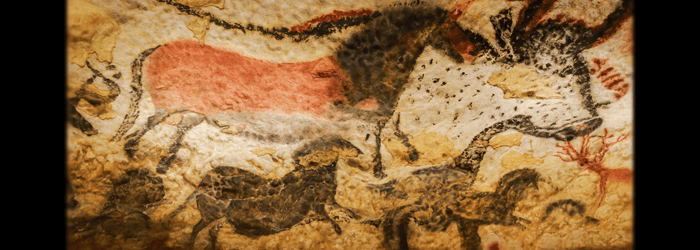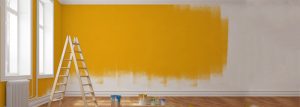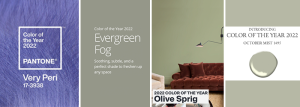Our world is full of color! Whether nature or man-made, humans have been coloring their world for thousands of years.
So, how did today’s paint come to be, and how much has its composition changed over time?
Pigments
Humans have used pigments, the color in paint, for quite some time. Earth Date notes the oldest discovery of ground ochre and charcoal is more than 100,000 years old. The mixture was found in South Africa’s Blombos Cave. Around 40,000 years ago, people living in Europe, Indonesia, and Australia painted images of hunters and animals on the stone walls of caves. The more widely known example is the Lascaux Cave. Located in southern France, its images were painted about 25,000 years ago.
Ancient paint mixtures were made from a variety of sources. Early paint mixed pigments from plants, and minerals, such as iron ore, with water, saliva, animal fats, and urine to create images and to color themselves. The Lascaux Cave depicted to the right, was near a well-used ancient iron ore mine.
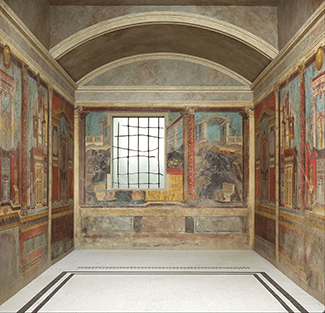
Blood, saps, berry juices, dried plants, charcoal, and roots were also used to generate a basic color palette. The Egyptians improved their binding agents with eggs and beeswax. They also utilized a wider variety of minerals that increased the colors available. Green malachite and blue azurite were added to the binding agent to increase the available colors. The Egyptians also introduced plaster. The new binding agents afforded the paints to adhere better to this new medium.
As an art form, painting on dried plaster began in Egypt. The Greeks made the leap to painting frescos on wet plaster. The Romans expanded this method of painting by adding to the vibrancy of colors. Some historians, such as the Royal Society of Chemistry, say the Greek method is considered the “True Fresco” painting. The Greeks also made lead-based white paint that was widely used in the ancient world. This basic white paint remained pretty much the same until the nineteenth century. More on lead paint later.
The Romans utilized Greek and Egyptian materials to make the paint used during their time. The Romans had a larger trade network that afforded the makers of paint a wider variety of sources for pigments. Again, new sources add new colors. The image from the Metropolitan Museum of Art depicts the “cubiculum” or bedroom from the Villa of P. Fannius Synistor at Boscoreale. Note the intricate depictions and see the color palate that was widely used.
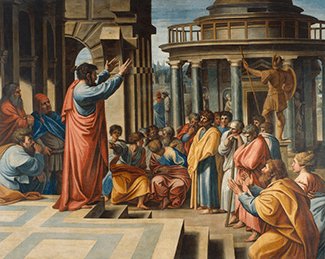
The colors’ appearance is a function of the binding agents used at this time. It wasn’t until the Renaissance period that oils were used as binding agents. This dramatically changed the vibrancy of the colors. The paintings done during this period are close to the original vibrancy. The artwork to the right of the Sistine Chapel depicts St. Paul Preaching in Athens. Note the difference in the vibrancy of the colors.
The American Coatings Association tells us that until the advent of the Industrial Revolution, paint manufacturing was a small business at best. The first recorded paint mill was opened in Boston in 1700 by Thomas Child. By then the manufacturing of paint began its industrial march. The paint was still difficult to ship because it was heavy and bulky. Therefore, many folks continued to mix their own with the powdered pigments they could purchase. However, that changed in 1867 when D.R. Averill patented the first pre-prepared or “ready mixed” paints.
Paint availability took a gigantic leap forward. Due to the difficulty of shipping, paint mills started springing up throughout the country. The process of manufacturing paint became less specialized. Friend of Rosie on the House, Sherwin-Williams, was founded in 1866 in Cleveland, Ohio. The paint manufactured over its 150-plus-year history remain popular with our Rosie on the House Certified Partners.
The mid-1880s saw the industry remain dispersed in population and industrial centers throughout the U.S. This was the norm until the mid-1900s. During the early 1900s, the boom in industrial production created a market for all types of paints and coatings. Assembly line products also needed some way to protect themselves. Paint and coating were the answer.
Lead Paint
The Greeks were the first to use lead-based paints. Evidence suggests that lead poisoning was known back then. The overexposure of the lead manufacturing process has been documented throughout history. Its use in paints, however, was not addressed until WWII. When the adverse impacts of low exposure in paint products became apparent, the industry voluntarily replaced some of their lead-based pigments when alternatives became available. During the 1950s, the industry began to eliminate lead-based products from all house paints. In 1978 the Consumer Product Safety Commission banned its use entirely.
Important: If you are remodeling a house that was built before 1978, follow the Environmental Protection Agency’s Lead Paint Guidelines.
Modern Paint
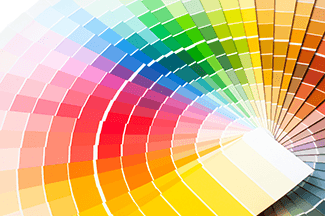 Today, synthetic pigments allow paint to be available in just about any color you can imagine. Walk into any Sherwin-Williams paint store and look at the array of colors that would stagger ancients.
Today, synthetic pigments allow paint to be available in just about any color you can imagine. Walk into any Sherwin-Williams paint store and look at the array of colors that would stagger ancients.
Many of our listeners and readers ask what the difference is between cheap paint and premium paint, and whether premium paint is worth it. Cheaper paints are thinner, have less pigment, and have less binder. This causes the paint to coagulate, drip, and show brush marks more readily, and most importantly, they do not provide full coverage. This means that several coats will need to be applied, thus using more paint. So, the simple answer is yes. Premium paint is definitely worth it!
Another aspect of paint you may want to consider is the color’s Light Reflective Value (LRV). This is a measure of visible and usable light that is reflected from a surface when illuminated by a light source. Generally, the lighter the color, the higher the LRV. This has become more important as homeowner associations’ architectural review committees have set guidelines for exterior home colors. Typically, these are regulated by a color LRV.
Paint and coatings have become an integral and vital part of our daily lives. They will also remain an important part of our environment as trends change over the years.
###
PODCAST
Where did today’s paint come from and how much has its composition changed over time? From its earliest forms used in ancient drawings, Roman and Greek pigments to binding agents in the Renaissance period, paint has an interesting history with many different mixing agents that might surprise you. Joined by Arizona Painting Company’s Doug Caris, we paint the story.
Podcast Archive With Expanded Content and Resources
PHOTO CREDIT
- Metropolitan Museum of Art
- Royal Academy of Arts
- Shutterstock

